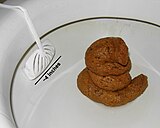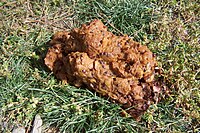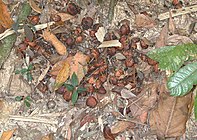Feces
Feces (or faeces; sg.: faex) (also known as poop, stool waste, shit, defecation, excrement or crap) are the solid or semi-solid remains of food that was not digested in the small intestine, and has been broken down by bacteria in the large intestine.[1][2] Feces contain a relatively small amount of metabolic waste products such as bacterially altered bilirubin, and dead epithelial cells from the lining of the gut.[1]
Feces are discharged through the anus or cloaca during defecation.
Feces can be used as
.
Characteristics

The distinctive odor of feces is due to skatole, and thiols (sulfur-containing compounds), as well as amines and carboxylic acids. Skatole is produced from tryptophan via indoleacetic acid. Decarboxylation gives skatole.[3][4]
The perceived bad odor of feces has been hypothesized to be a deterrent for humans, as consuming or touching it may result in sickness or infection.[5]
Physiology
Feces are discharged through the anus or cloaca during defecation. This process requires pressures that may reach 100 millimetres of mercury (3.9 inHg) (13.3 kPa) in humans and 450 millimetres of mercury (18 inHg) (60 kPa) in penguins.[6][7] The forces required to expel the feces are generated through muscular contractions and a build-up of gases inside the gut, prompting the sphincter to relieve the pressure and release the feces.[7]
Ecology
After an animal has digested eaten material, the remains of that material are discharged from its body as waste. Although it is lower in energy than the food from which it is derived, feces may retain a large amount of energy, often 50% of that of the original food.[8] This means that of all food eaten, a significant amount of energy remains for the decomposers of ecosystems.
Many organisms feed on feces, from bacteria to fungi to insects such as
Feces and urine, which reflect
Seeds also may be found in feces. Animals who eat fruit are known as frugivores. An advantage for a plant in having fruit is that animals will eat the fruit and unknowingly disperse the seed in doing so. This mode of seed dispersal is highly successful, as seeds dispersed around the base of a plant are unlikely to succeed and often are subject to heavy predation. Provided the seed can withstand the pathway through the digestive system, it is not only likely to be far away from the parent plant, but is even provided with its own fertilizer.
Organisms that subsist on dead organic matter or detritus are known as detritivores, and play an important role in ecosystems by recycling organic matter back into a simpler form that plants and other autotrophs may absorb once again. This cycling of matter is known as the biogeochemical cycle. To maintain nutrients in soil it is therefore important that feces returns to the area from which they came, which is not always the case in human society where food may be transported from rural areas to urban populations and then feces disposed of into a river or sea.
Human feces
Depending on the individual and the circumstances, human beings may defecate several times a day, every day, or once every two or three days. Extensive hardening of the feces that interrupts this routine for several days or more is called constipation.
The appearance of human fecal matter varies according to diet and health.
After the
At different times in their life, human beings will expel feces of different colors and textures. A stool that passes rapidly through the intestines will look greenish; lack of bilirubin will make the stool look like clay.
Uses of animal feces
Fertilizer
The feces of animals, e.g. guano and manure, often are used as fertilizer.[12]
Energy
Animals such as the
Coprolites and paleofeces
A
The reason this analysis is possible at all is due to the digestive system not being entirely efficient, in the sense that not everything that passes through the digestive system is destroyed. Not all of the surviving material is recognizable, but some of it is. Generally, this material is the best indicator archaeologists can use to determine ancient diets, as no other part of the archaeological record is so direct an indicator.[20]
A process that preserves feces in a way that they may be analyzed later is the Maillard reaction. This reaction creates a casing of sugar that preserves the feces from the elements. To extract and analyze the information contained within, researchers generally have to freeze the feces and grind it up into powder for analysis.[21]
Other uses

Animal dung occasionally is used as a cement to make adobe mudbrick huts,[22] or even in throwing sports, especially with cow and camel dung.[23]
In northern
Elephants, hippos, koalas and pandas are born with sterile intestines, and require bacteria obtained from eating the feces of their mothers to digest vegetation.
In India,
Terminology
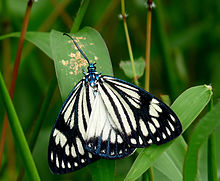
Feces is the scientific terminology, while the term stool is also commonly used in medical contexts.[29] Outside of scientific contexts, these terms are less common, with the most common layman's term being poop or poo. The term shit is also in common use, although it is widely considered vulgar or offensive. There are many other terms, see below.
Etymology
The word faeces is the plural of the
Synonyms
"Feces" is used more in biology and medicine than in other fields (reflecting science's tradition of classical Latin and Neo-Latin)
- In hunting and tracking, terms such as dung, scat, spoor, and droppings normally are used to refer to non-human animal feces
- In husbandry and farming, manure is common.
- Stool is a common term in reference to stool sample sometimes is requested for testing purposes.[32]
- The term bowel movement(s) (with each movement a defecation event) is also common in health care.
There are many synonyms in informal
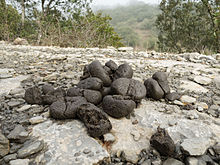
Feces of animals
The feces of animals often have special names (some of them are slang), for example:
- Non-human animals
- As bulk material – dung
- Individually – droppings
- Cattle
- Bulk material – cow dung
- Individual droppings – cow pats, meadow muffins, etc.
- Deer (and formerly other quarry animals) – fewmets
- Wild carnivores – scat
- Otter – spraint
- Birds (individual) – droppings (also include urine as white crystals of uric acid)
- Seabirds or bats (large accumulations) – guano
- Herbivorous insects, such as caterpillars and leaf beetles – frass
- worm castings(feces extruded at ground surface)
- Feces when used as fertilizer (usually mixed with animal bedding and urine) – manure
- Horses– horse manure, roadapple (before motor vehicles became common, horse droppings were a big part of the rubbish communities needed to clean off roads)
Society and culture
Feelings of disgust
In all human cultures, feces elicit varying degrees of disgust in adults. Children under two years typically have no disgust response to it, suggesting it is culturally derived.[33] Disgust toward feces appears to be strongest in cultures where flush toilets make olfactory contact with human feces minimal.[34][35] Disgust is experienced primarily in relation to the sense of taste (either perceived or imagined) and, secondarily to anything that causes a similar feeling by sense of smell, touch, or vision.
Social media
There is a
Jokes
Poop is the center of toilet humor, and is commonly an interest of young children and teenagers.[38]
Gallery
- Feces samples
-
Bear scat
-
Bear scat showing consumption of bin bags
-
The cassowary disperses plant seeds via its feces
-
Earthworm feces aids in provision of minerals and plant nutrients in an accessible form
-
Feces from different seabirds
See also
References
- ^ ISBN 978-0-06-350729-6.
- ^ a b c Diem, K.; Lentner, C. (1970). "Faeces". in: Scientific Tables (Seventh ed.). Basle, Switzerland: CIBA-GEIGY Ltd. pp. 657–660.
- PMID 18223109.
- PMID 367144.
- PMID 15252963.
- ^ Langley, Leroy Lester; Cheraskin, Emmanuel (1958). The Physiology of Man. McGraw-Hill. Archived from the original on 1 August 2020. Retrieved 3 December 2019.
- ^ S2CID 43386022.
- ^ Cummings, Benjamin; Campbell, Neil A. (2008). Biology, 8th Edition, Campbell & Reece, 2008: Biology (8th ed.). Pearson. p. 890.[permanent dead link]
- .
- ^ "Document: Krestel". City of Manhattan, Kansas. Retrieved 11 February 2012.[permanent dead link]
- ^ Stromberg, Joseph (22 January 2015). "Everybody poops. But here are 9 surprising facts about feces you may not know". Vox. Archived from the original on 17 November 2019. Retrieved 3 December 2019.
- ISBN 978-3527306732.
- ^ "STCWA". Archived from the original on 13 March 2021. Retrieved 16 March 2021.
- ^ Handwerk, Brian (11 September 2013). "Panda Poop Might Help Turn Plants Into Fuel". National Geographic. Archived from the original on 3 December 2019. Retrieved 3 December 2019.
- ^ Ray, Kathryn Hobgood (25 August 2011). "Cars Could Run on Recycled Newspaper, Tulane Scientists Say". Tulane News. Archived from the original on 4 March 2022. Retrieved 3 December 2019.
- ^ Handwerk, Brian (9 November 2005). "Bacteria Eat Human Sewage, Produce Rocket Fuel". National Geographic News. Archived from the original on 13 March 2020. Retrieved 3 December 2019 – via wildsingapore.com.
- PMID 22138989.
- ^ "Definition of coprolite | Dictionary.com". dictionary.com. Archived from the original on 9 November 2020. Retrieved 16 March 2021.
- PMID 11296282.
- ISBN 978-0-19-533117-2. Archivedfrom the original on 1 August 2020. Retrieved 3 December 2019.
- S2CID 83373644.
- ^ "Your Home Technical Manual – 3.4d Construction Systems – Mud Brick (Adobe)". Archived from the original on 6 July 2007. Retrieved 9 July 2007.
- ^ "Dung Throwing contests". Australian Broadcasting Corporation. Archived from the original on 11 October 2007.
- ^ a b Topper, R (15 October 2012). "Elephant Dung Coffee: World's Most Expensive Brew Is Made With Pooped-Out Beans". HuffPost. Archived from the original on 3 September 2017. Retrieved 10 December 2012.
- ^ "pure". Oxford English Dictionary (Online ed.). Oxford University Press. (Subscription or participating institution membership required.) n., 6
- ^ "Rohm and Haas Innovation - The Leather Breakthrough". Rohmhaas.com. 1 September 1909. Archived from the original on 19 October 2012. Retrieved 27 October 2012.
- from the original on 4 March 2022. Retrieved 21 February 2021.
- ^ Ramachandran, Smriti Kak (19 March 2015). "Cow dung, urine can cure cancer: BJP MP". The Hindu. Archived from the original on 1 October 2019. Retrieved 17 September 2019.
- ^ "stool". Archived from the original on 11 March 2019. Retrieved 18 April 2017 – via The Free Dictionary.
- ^ "Feces definition – Medical Dictionary definitions of popular medical terms easily defined on MedTerms". Medterms.com. 19 March 2012. Archived from the original on 11 November 2013. Retrieved 11 November 2013.
- ^ Houghton Mifflin Harcourt, The American Heritage Dictionary of the English Language, Houghton Mifflin Harcourt, archived from the original on 25 September 2015, retrieved 17 March 2015.
- ^ Steven Dowshen, MD (September 2011). "Stool Test: Bacteria Culture". Kidshealth. Archived from the original on 19 February 2012. Retrieved 11 February 2012.
- PMID 30425610.
- ^ "Yes, poop is gross. But that's not the only reason for its shameful social stigma". Upworthy. 25 May 2016. Archived from the original on 31 July 2020. Retrieved 8 April 2020.
- ^ Goldman, Jason G. "Why do humans hate poo so much?". BBC. Archived from the original on 31 March 2019. Retrieved 8 April 2020.
- ^ "The Oral History Of The Poop Emoji (Or, How Google Brought Poop To America)", Fast Company, 18 November 2014, archived from the original on 3 April 2018, retrieved 9 November 2016
- ^ Darlin, Damon (7 March 2015), "America Needs its own Emojis", The New York Times, archived from the original on 30 October 2016, retrieved 1 March 2017
- ISBN 978-1-932595-21-5.


